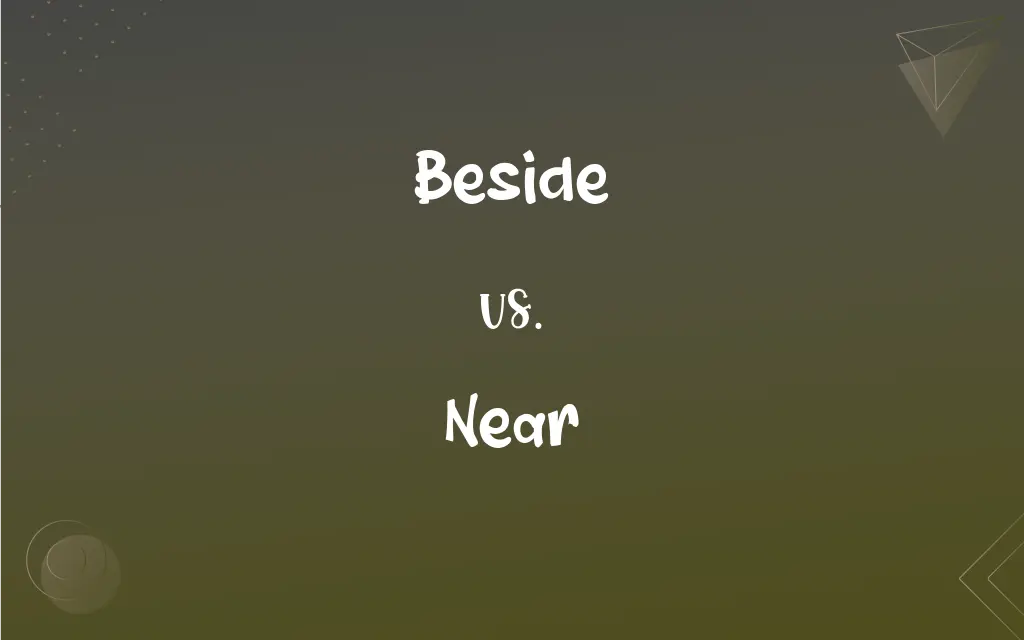Beside vs. Near: What's the Difference?
Edited by Aimie Carlson || By Harlon Moss || Updated on November 2, 2023
Beside means next to or at the side of something; near indicates a short distance from something without specifying an exact location.

Key Differences
Beside is a preposition that signifies proximity with a clear point of reference, indicating that one object is at the side of another. It implies a closer relationship or position, suggesting that two entities are alongside each other, often touching or in close arrangement. The term "beside" conveys a specific positional context, providing a sense of immediacy and directness to the relationship between two entities.
Near is a more flexible preposition that describes closeness in terms of distance rather than position. It does not require the objects to be side by side; instead, it implies that they are within a short distance of each other, which can be a few steps to a few miles. "Near" can be relative and does not necessarily denote direct contact or immediate vicinity, unlike "beside."
Beside focuses on the spatial relationship from a two-dimensional perspective, typically on the same level or plane. This preposition is less about the distance and more about the position, indicating lateral proximity. Using "beside," one can infer a specific orientation of objects or persons in relation to one another.
Near, conversely, does not prioritize a specific plane or level and can refer to three-dimensional proximity. It encompasses a broader range of closeness and can often be subjective, depending on the context. "Near" can refer to proximity in a physical sense but can also imply a closer connection in a more abstract or emotional sense.
Beside can also carry metaphorical meanings, implying support or comparison, such as in "beside the point" or "beside oneself with grief," indicating a state of being overwhelmed. Near, while it can be used metaphorically as well, generally retains its core meaning related to physical closeness and does not often diverge into the realms of emotion or abstraction to the same extent as "beside."
ADVERTISEMENT
Comparison Chart
Prepositional Use
Used to indicate direct contact or proximity to the side of something.
Used to indicate a close proximity, without specifying side or direct contact.
Spatial Relationship
Lateral and specific; "A is beside B" means A is next to B.
General closeness; "A is near B" means A is close to B but not necessarily beside.
Emotional Connotation
Can imply support or being overwhelmed when used metaphorically.
Less commonly used metaphorically, usually retains physical closeness meaning.
Specificity
More specific, often implying touching or in immediate vicinity.
Less specific, can range from very close to a broader surrounding area.
Dimensional Context
Usually two-dimensional, on the same plane.
Can imply three-dimensional closeness, not limited to a plane.
ADVERTISEMENT
Beside and Near Definitions
Beside
In comparison with.
Beside his work, mine seemed amateur.
Near
At a short distance from.
The library is near the school.
Beside
Next to, or at the side of something.
She sat beside her friend at the concert.
Near
Shortly before or after a point in time.
The project's deadline is near.
Beside
At the side of, literally or figuratively.
He stood beside the statue for a photo.
Near
Almost; nearly.
She was near tears after the movie.
Beside
Aside from or apart from.
Beside the main issue, there are several small problems.
Near
On the verge or close to reaching a state.
He is near completion of his degree.
Beside
Indicating support or alignment with someone.
The coach stood beside the player during the controversy.
Near
Related to someone or something.
They were near strangers, meeting for the first time.
Beside
At the side of; next to.
Near
To, at, or within a short distance or interval in space or time
Moved the table nearer to the wall.
As graduation draws near.
Beside
In comparison with
A proposal that seems quite reasonable beside the others.
Near
Just about; almost; nearly
Was near exhausted from the climb.
FAQs
Is "beside" only used for physical proximity?
No, "beside" can also be used metaphorically, such as "beside oneself with joy."
Does "near" indicate a specific distance?
No, "near" is relative and can vary from a few steps to a broader area.
Can "beside" imply emotional support?
Yes, "beside" can imply support, as in "standing beside someone" in a time of need.
Is "near" used in temporal contexts as well?
Yes, "near" can indicate closeness in time, not just in space.
Do "beside" and "near" have the same level of specificity?
No, "beside" is usually more specific, indicating side-by-side proximity.
In which contexts would "beside" be more appropriate than "near"?
"Beside" is more appropriate when referring to something directly at the side of another.
Can "beside" imply equality or parity?
It can imply spatial equality but not necessarily status or value equality.
Can "beside" and "near" be used interchangeably?
No, "beside" implies being next to while "near" implies general closeness without being specific.
Is "near" appropriate for use in directions?
Yes, "near" is often used to give directions due to its flexibility in indicating proximity.
Can "near" be used metaphorically?
It can, but it is less common than its use to indicate physical proximity.
What is a synonym for "beside"?
"Alongside" is a close synonym for "beside."
Does "beside" have an adverbial form like "near" does with "nearly"?
No, "beside" does not have an adverbial form.
Can "beside" be used to compare two things?
Yes, as in the phrase "beside the point."
What is a synonym for "near"?
"Close to" is a synonym for "near."
Is "beside" formal or informal language?
"Beside" can be used in both formal and informal contexts.
Is "near" a more versatile word than "beside"?
Yes, "near" can be used in a wider range of contexts and dimensions.
How does "near" function in a sentence?
As a preposition or adverb indicating proximity.
Can "beside" mean "in addition to"?
No, "beside" does not mean "in addition to"; "besides" with an "s" does.
Does "beside" ever indicate distance rather than position?
Typically, "beside" refers to position rather than distance.
Can "near" be used as a preposition and an adverb?
Yes, "near" can be used as both a preposition and an adverb.
About Author
Written by
Harlon MossHarlon is a seasoned quality moderator and accomplished content writer for Difference Wiki. An alumnus of the prestigious University of California, he earned his degree in Computer Science. Leveraging his academic background, Harlon brings a meticulous and informed perspective to his work, ensuring content accuracy and excellence.
Edited by
Aimie CarlsonAimie Carlson, holding a master's degree in English literature, is a fervent English language enthusiast. She lends her writing talents to Difference Wiki, a prominent website that specializes in comparisons, offering readers insightful analyses that both captivate and inform.































































